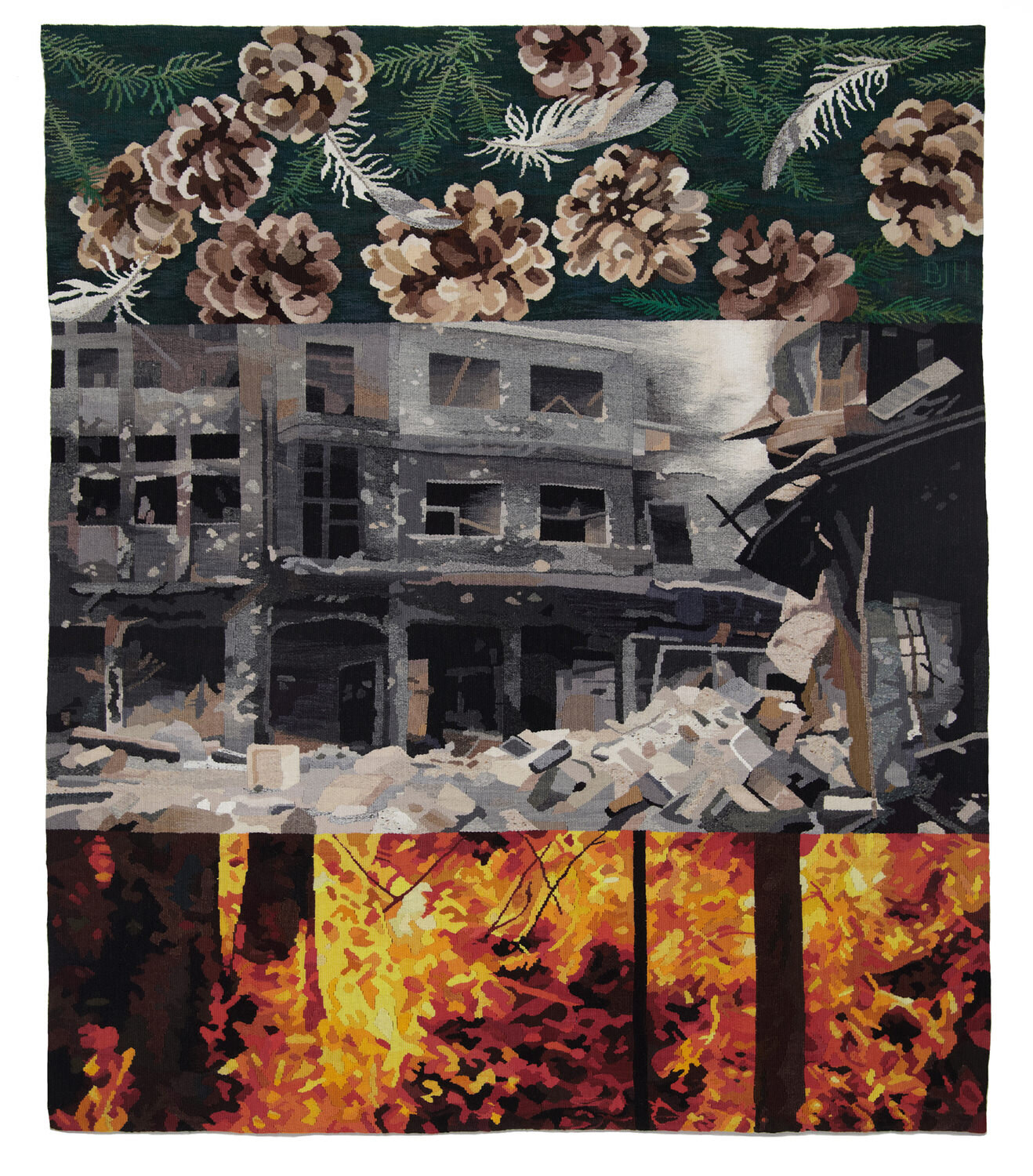Borders in Tapestries... Barbara Heller and Joan Baxter
This week I’m sharing the work of two more of my favorite tapestry artists and the application of borders in their work: Barbara Heller and Joan Baxter.
Last week in the post on Julia Mitchell’s tapestries, I showed some examples of transparency in borders. Both Barbara and Joan are masters of the transparency, as you’ll see in the images here.
Barbara Heller
Barbara Heller, Babylon Has Fallen, 1996/97, 48 x 65, 122 x 165 cm
Barbara told me that when she does not want the border to be a major feature in a piece, she would use a texture or color shift to delineate the border area, becoming “more an integrated wrapping.” She wrote that she had been stretching most of her work up to 2000, but felt the tapestries were like paintings and needed a frame. With Babylon, and later Still Life, she chose to use a border and not a frame to demarcate the edges of the tapestry. She added she feels it is more fitting of a textile. I so agree!
Barbara Heller, Still Life…with Bird, 2003, 5’ x 5’, 152 x 152 cm
I love the way the border dissolves and crumbles into the imagery of the towers falling in Still Life… With Bird. Another element here that Barbara uses is the small frames along the bottom, depicting more hints, or “adjectives” as Kathy Spoering referred to bordered elements, into the narrative.
“Borders are liminal spaces leading the viewer into the central image and as such can contain extra information or be decorative or act as a frame or tell a second story or… The choice is the artist’s.”
-Barbara Heller
Barbara Heller, Regeneration, 2016/17, 63 x 70 inches, 160 x 180 cm
In Regeneration, she used very wide borders on the top and bottom, which take up nearly two thirds of the piece. In true narrative form, we tend to “read” it, not from left to right, but from bottom to top as it was woven.
The border on Tzimtzum: Transcendence follows the steps of the rising through subtle color changes at each transformation. The border creates a balance between space and focus - and adds a sense of serenity.
Barbara Heller, Tzimtzum: Transcendence, 2015/16, 4’x8,’ 122 x 244 cm
You can see more of Barbara’s work on her website, and definitely check out an extensive interview from Zone One Arts that includes a video - in the form of another interview - of her solo exhibition at the Elliott Louis Gallery.
Joan Baxter
Joan’s work takes on an etherial quality. Her “borders” are not clearly defined, but often more of a collage effect. And transparency is a key element.
Joan Baxter, Summerstones, 2001, 55cms w x 120cms h
About Summerstones, she writes…
“When I was about half way up the tapestry 9/11 happened and I needed to mark it, so instead of just a plain border with the shadow of the big stone within it, I found myself weaving clouds of solid looking smoke with the two towers behind and through the ancient stone.”
Joan Baxter, The White Boat of Winter, 2010/2022, 255cms w x 72cms h
On a recent blog post for the British Tapestry Group, she writes
“I liked how a rectangular or partial frame allowed the tapestry to breathe – giving it an intermediate zone between the action in the tapestry and the wall it hangs on. Later in my boat pieces the frame was concealed within the curving lines of the compositional structures that I liked at that time.”
(I did not include the other boat pieces she may have been referring to, but you can see one here).
Joan Baxter, Short Thaw, 2011, 115 cms w x 30 cms h
I love her use of shapes - often swirling - as in the above piece, Short Thaw. Her “borders” appear to fade in and out, blurring the lines, in perfect keeping with her imagery.
Borders within borders within borders…drawing you into the central image.
Which is especially true for the complexity of Hallaig.
Joan Baxter, Hallaig, ~2012, 2m x 1.6m
Joan writes a bit about the making and structure of Hallaig on her website:
“…’The window is nailed and boarded through which I saw the West and my love is at the burn of Hallaig, a birch tree.' The first line of the poem gives me the broad compositional structure for the tapestry. I have used a darker frame round a lighter rectangle with a slim horizontal band of dark blue at the top. The whole composition is divided by a much lighter narrow vertical strip. This simple vertical/horizontal structure quotes woven structures of warp and weft and is like part of a tartan or checked cloth. The frame denotes a sense of the boarded up window. The inner rectangle represents the past and the outer frame the present. The light vertical slash is the young love, likened to a young tree, who haunts the whole poem.” - Joan Baxter, Read full article.
Actually, she writes about most of her other pieces on her website, too, which you will surely find of interest! Click on the links in the captions to go directly to each page.
But don’t stop there; there are so many more to explore…
I hope you’ve enjoyed these posts on Borders in Tapestries. I could continue on and on with them, but for now this concludes the series. I’m sure I will revisit this theme another day!







